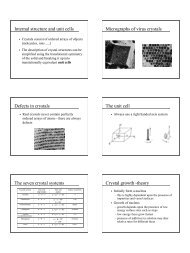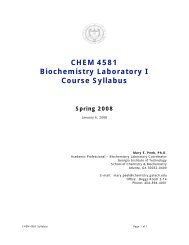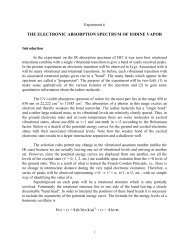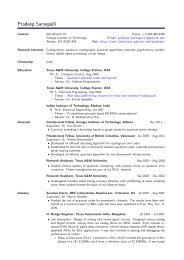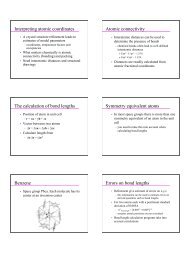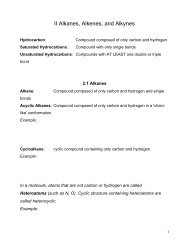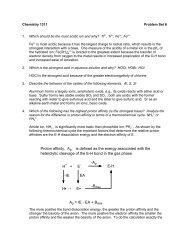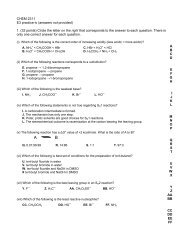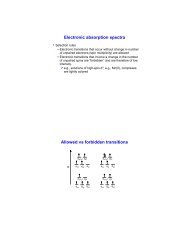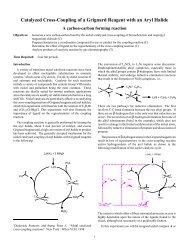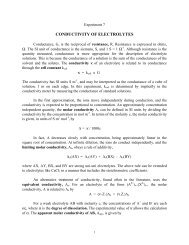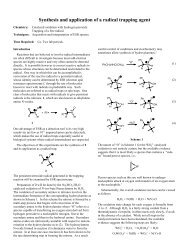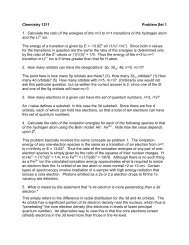Exam 3
Exam 3
Exam 3
- No tags were found...
Create successful ePaper yourself
Turn your PDF publications into a flip-book with our unique Google optimized e-Paper software.
Name:_____________________________GT Student ID:_____________________________CHEM 2312 Third <strong>Exam</strong> 12 March 2010In taking this examination, you are expected to adhere to the GT academic honor code. At a minimum this requires thatyou utilize only the materials supplied to you, and that you do not give help to, or accept help from, others.(60 points) Multiple choice:1. What would be the final product of the following reaction sequence?1. PBr 32. Mg, etherOH3. PhCHO4. H 2 O5. Na 2 Cr 2 O 7 , H 2 SO 4a.OHOb. c. d.OHC2. What would be the product of the following reaction sequence?1. Mg, etherBr2. D 2 OD HODa. b. c. d.CH 2 D3. Select the reagent(s) for the following reaction:OOHa. (1) LiAlH 4 , ether (2) H 2 O d. (a) and (b)b. (1) NaBH 4 ; (2) H 3 O + e. (a), (b), and (c)c. H 2 with Pd/C4. Which synthesis of a Grignard reagent would fail to occur as written?
a.OBrMg, etherOMgBrc.BrMg, etherMgBrb.NCBrMg, etherNCMgBrd.BrMg, etherMgBr5. What is the IUPAC name for the following compound?Oa. 1,1,2-Trimethyl-1,3-hexenone d. 2,3-Dimethyl-2-hepten-4-oneb. 1,2-Dimethyl-1,3-hexenone e. 5,6-Dimethyl-5-hepten-4-onec. 2,3-Dimethyl-1,3-heptenone6. Which of the following compounds is a hemiacetal?HOa. b. c. d.O OH O OCH 3 HO OHO7. What is the product of the following reaction sequence?OH1. PCC, CH 2 Cl 22. BrCH 2 CO 2 Et, Zn, benzene3. H 3 O +a.OOOEtOOEtOb. c.OOHOOEtOHOOEtOOEtd. e. f.OEtOOOH8. Which of these diols is expected to be the most stable?HO OHHO OHHO OHa.F 3 C CF 3b.H 3 C Hc.H 3 C CH 3d.HOPhOHHe.HOHOHCl
13. (6 points) For each of the following pairs, circlea) the more electrophilic molecule:Ovs.Ob) the more nucleophilic molecule (hint: difference in hybridization is important here):MgBrvs.MgBr14. (10 points) Write a detailed step-by-step mechanism for the following conversion:HOOHH 3 O +H 2 OHOOOH
15. (24 points) Each of the following transformations cannot be performed in a single step. Provide a sequenceof reactions to perform each transformation, showing the reagents and structures of all isolated syntheticintermediates. You may assume that mixtures of isomers can be separated. Do NOT provide mechanisms,just the synthetic steps. NOTE: All carbon atoms in the product must be derived from the given startingmaterial(s).a)OHOHandb)OH




